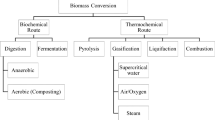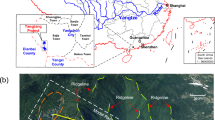Abstract
The aim of this work was to establish a mathematical model for the analysis of calcining process of petroleum coke in a 24-pot calciner via computational fluid dynamics (CFD) numerical simulation method. The model can be divided into two main parts (1) heterogeneous reacting flow of petroleum coke calcination in the pot was simulated using a two-fluid model approach where the gas and solid phase are treated as a continuous phases; and (2) the standard turbulence equations combined with the finite rate/eddy-dissipation combustion model and discrete ordinates model were solved for the turbulent gas reacting flow in the flue. The model of the calcining process was implemented in ANSYS Fluent 15.0 (commercial CFD software) and validated by industrial production data. After the validation research, the model has been applied to inspect the distribution features of the temperature field in the furnace, the concentration field of residual moisture and volatiles in the petroleum coke, and the vector velocity field of gas and solid phases. This research can provide a theoretical basis for optimizing the structure and improving the automatic control level of a pot calciner.






Similar content being viewed by others
Abbreviations
- A i :
-
Pre-exponential factor (1/s)
- A ij :
-
Mass fraction of species i in element j
- B j :
-
Mass of element j (kg)
- C 1, C 2, C µ :
-
Turbulence model constants
- C p :
-
Specific heat (J/(kg K))
- D :
-
Diffusion coefficient (m2/s)
- d p :
-
Particle diameter (m)
- E i :
-
Activation energy (J/mol)
- F d :
-
Momentum source term (N/m3)
- f w :
-
Friction at wall (N/m3)
- g :
-
Gravitational acceleration (m/s2)
- G k :
-
Production of turbulence kinetic energy (kg/(m s3))
- H :
-
Mean enthalpy (W/m3)
- h:
-
Heat transfer coefficient (W/(m2 K))
- \(h_{j}^{0}\) :
-
Standard-state enthalpy (J/mol)
- k :
-
Turbulent kinetic energy (m2/s2)
- k i :
-
Reaction rate constant (1/s)
- M w,i :
-
Molecular weight of species i (kg/mol)
- M :
-
Volatiles to gas source term (kg/(m3 s))
- m i :
-
Mass of species i (kg)
- p :
-
Pressure (Pa)
- Q c :
-
Convective heat transfer term (W)
- Q g :
-
Heat of chemical reaction term (W)
- Q r :
-
Heat transfer term associated with radiative heat transfer (W)
- R :
-
Gas constant (J/mol K)
- r i,r :
-
Arrhenius molar rate of creation/destruction of species i in reaction r (mol/(m3 s))
- R i :
-
Chemical reaction of species i mass term (kg/(m3 s))
- S h :
-
Heat term from volatiles (W/m3)
- S :
-
Mass source term (kg/(m3 s))
- S s :
-
Specific surface area (m2/m3)
- T :
-
Temperature (K)
- U :
-
Velocity vector (m/s)
- u,v,w :
-
Velocity magnitude (m/s)
- V Loss :
-
Mass loss fraction of pyrolysis and burning
- W in :
-
Mass of dried petroleum coke (kg)
- Y :
-
Mass fraction of species
- α :
-
Volume fraction
- ε :
-
Turbulent dissipation rate (m2/s3)
- ε s :
-
Bed porosity
- σ k , σ ε :
-
Turbulence model constant
- λ :
-
Thermal conductivity (W/(m K))
- ρ :
-
Density (kg/m3)
- µ :
-
Dynamic viscosity (Pa s)
- µ t :
-
Turbulent viscosity (Pa s)
- µ eff :
-
Effective viscosity (Pa s)
- \(\varGamma_{{i,{\text{eff}}}}\) :
-
Effective diffusion coefficient (m2/s)
- \(\varGamma_{i}\) :
-
Molecular diffusivity of species i (m2/s)
- \(\varGamma_{\text{t}}\) :
-
Turbulent diffusivity of species i (m2/s)
- \(\varepsilon_{{\text{ext}}}\) :
-
Emissivity of the external wall surface (1/m)
- eff:
-
Effective
- e:
-
Element count
- g:
-
Gas phase
- w:
-
Wall
- s:
-
Solid phase
- i :
-
Gas component
- j :
-
Solid component
- n, m :
-
Gas/solid species count
- FC:
-
Fixed carbon and ash
References
S. Zhou, Y. Sun, and C. Liu, Light Met 12, 33 (2013)
P. Wang, Production and Application of Aluminum Electrolytic Carbon Anode (Metallurgical Industry Press, Beijing, 2005), pp. 61–73
M.A. Martins, L.S. Oliveira, and A.S. Franca, Fuel 80, 1611 (2001)
C. Zhang, Light Met. 08, 38 (2008)
H. Li, X. Wang, and K. Yang, Light Met. 03, 43 (2011)
F. Patisson, E. Lebas, F.O. Hanrot, D. Ablitzer, and J. Houzelot, Metall. Mater. Trans. B 31, 381 (2000)
M.S. Manju and S. Savithri, Fuel 102, 54 (2012)
Q. Zheng and H. Wei, Energy Fuels 27, 3570 (2013)
Y. Feng, X. Zhang, Q. Yu, Z. Shi, Z. Liu, H. Zhang, and H. Liu, Appl. Therm. Eng. 28, 1485 (2008)
J. Chen, T. Akiyama, H. Nogami, J. Yagi, and H. Takahashi, ISIJ Int. 33, 664 (1993)
R.T. Bui, G. Simard, and A. Charette, Can. J. Chem. Eng. 73, 534 (1995)
Ł. Słupik, A. Fic, Z. Buliński, A.J. Nowak, L. Kosyrczyk, and G. Łabojko, Fuel 150, 415 (2015)
M.A. Gómez, J. Porteiro, D. Patiño, and J.L. Míguez, Fuel 117, 716 (2014)
Z. Guo and H. Tang, China Part. 3, 373 (2005)
P. Lin, J. Ji, Y. Luo, and Y. Wang, Appl. Therm. Eng. 29, 3224 (2009)
Y. Zhao, B. Lu, and Y. Zhong, Int. J. Multiph. Flow 71, 1 (2015)
M. Ishii and T. Hibiki, Thermo-Fluid Dynamics of Two-Phase Flow, vol. 2 (Springer, New York, 2010), pp. 156–177
S.R. Mathur, and J.Y. Murthy, J. Thermophys. Heat Transf. 13, 467 (1999)
R.K. Niven, Chem. Eng. Sci. 57, 527 (2002)
M.F. Modest, Radiative Heat Transfer, vol. 2 (Academic press, San Diego, 2013), pp. 498–536
A. Klimanek, W. Adamczyk, A. Katelbach-Woźniak, G. Węcel, and A. Szlęk, Fuel 152, 131 (2015)
S. Murgia, M. Vascellari, and G. Cau, Fuel 101, 129 (2012)
D.A. Kontogeorgos, E.P. Keramida, and M.A. Founti, Int. J. Heat Mass Transfer 50, 5260 (2007)
H. Zhou, A. Jensen, P. Glarborg, P. Jensen, and A. Kavaliauskas, Fuel 84, 389 (2005)
W. Song and T. Wang, J. Eng. Des. 06, 428 (2011)
C. Schönenbeck, R. Gadiou, and D. Schwartz, Fuel 83, 443 (2004)
W. Zhou, C.S. Zhao, L.B. Duan, C.R. Qu, and X.P. Chen, Chem. Eng. J. 166, 306 (2011)
A.R. Miroliaei, F. Shahraki, H. Atashi, and R. Karimzadeh, J. Ind. Eng. Chem. 18, 1912 (2012)
D. Merrick, Fuel 62, 540 (1983)
T.F. Smith, Z.F. Shen, and J.N. Friedman, J. Heat Transfer 104, 602 (1982)
C. Wang and L. Chen, J. Chongqing Univ. 34, 73 (2011)
P.R. Austin, H. Nogami, and J. Yagi, ISIJ Int. 37, 458 (1997)
B. Mao, J. Xu, and C. Wang, Gansu Metall. 30, 37 (2008)
P. Wang, Y. Luo, Z. Gong, Q. Li, Z. Tan, L. Jia, and Y. Yu, Carbon Tech. 28, 41 (2009)
D. Kocaefe, A. Charette, and L. Castonguay, Fuel 74, 791 (1995)
S.Z. Yong and A. Ghoniem, Fuel 97, 457 (2012)
Acknowledgements
This work was funded by the National Natural Science Foundation of China (51374253). The author is also grateful to Miss Li for the advice on this paper.
Author information
Authors and Affiliations
Corresponding author
Rights and permissions
About this article
Cite this article
Xiao, J., Huang, J., Zhong, Q. et al. Modeling and Simulation of Petroleum Coke Calcination in Pot Calciner Using Two-Fluid Model. JOM 68, 643–655 (2016). https://doi.org/10.1007/s11837-015-1667-2
Received:
Accepted:
Published:
Issue Date:
DOI: https://doi.org/10.1007/s11837-015-1667-2




